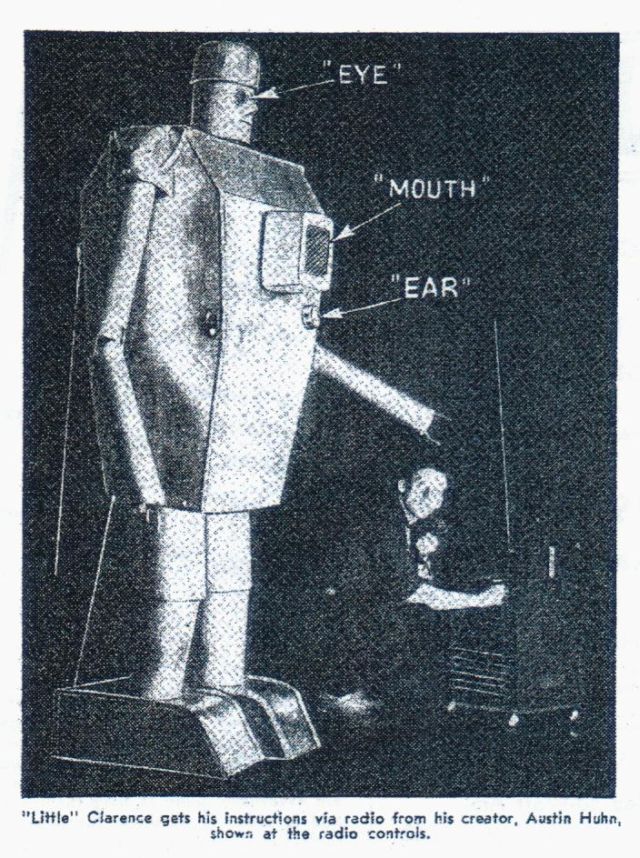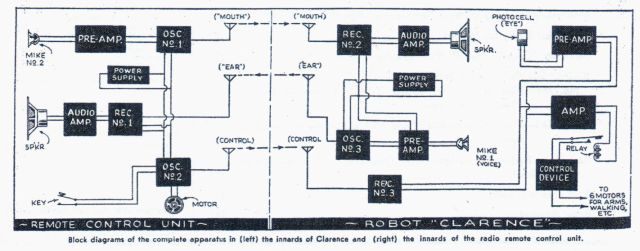
Above: Popular Science Aug 1940.
Below: Radio-Craft Oct 1939

extract from Radio-Craft Oct 39.
Clarence. RADIO ROBOT
Something new! A completely self-contained robot which operates within 150 ft. of a remote control unit. Oscillators—very similar to the currently popular " 'wireless' phono oscillator" supply control signals.
by AUSTIN HUHN
"CLARENCE," the "Man of Tomorrow," last month visited the New York World's Fair, and in many respects put to shame Westinghouse's $10,000 "Electro[sic]" and Bell Telephone's "Pedro the *Voder" (Both robots were described in August Radio-Craft.) because those mechanistic boys are pretty limited in ability. Pedro can't move anywhere, talks only when an operator permits him to with a regular lingual keyboard. Electro[sic] [sic] wanders only as far as the wires attached to him allow. He speaks predetermined platitudes.
But Clarence-ah, there's a mechanical man for you. He goes anywhere and says anything. There are no wires attached.
How does he work? Clarence himself told guests with Dave Driscoll and Jerry Danzig during WOR-Mutual's "Welcome Neighbor" program at the World's Fair, and answered a lot of very personal questions.
Clarence's papa, the writer, has devoted his spare time these 2 years past to perfecting the mechanical man and he is quite a bouncing hulk for a baby. He's 300 pounds in weight, stands 8 feet tall and is gentle as a kitten. Radio controlled, he operates, "by permission of the Federal Communications Commission," up to distances of 150 ft. from the Remote Control unit (at right in photo).
Clarence is the first mechanical man in the world who can wander around without trailing wires behind him. Furthermore, he uses no records or transcriptions but says anything which happens to come into his mind. The only flaw thus far found seems to be that Clarence is pretty poor at broadjumping, pole vaults and swimming.
HOW "HE" OPERATES
Clarence's walking and his arm movements are controlled by a photoelectric cell and by a radio beam. Both these methods were combined to insure dependable operation.
There are 2 separate receiving circuits in Clarence, and 1 oscillator with its corresponding preamplifier and microphone. In the Remote (concealed) Control unit there is 1 receiver, to hear via Clarence's ear, and 2 oscillators (see block diagram). The oscillators are similar in principle to the " 'wireless' phono oscillators" recently described in Radio-Craft, and like them, operate at one end of the broadcast band.
When Clarence "hears" a question being asked by an interlocutor or bystander Microphone No. 1 picks up the voice, passes it through a preamplifier to modulate Oscillator No. 3 over the "hearing" antenna on Clarence. This modulated signal is picked up by Receiver No. 1 on the Remote Control, is amplified and is heard through the speaker on the Control.
When Clarence "speaks," Microphone No. 2 on the Control is used. This signal is radiated from the antenna on the Control marked "mouth." It is received over the corresponding antenna on Clarence marked "mouth" by Receiver No. 2, is amplified and is heard through the speaker on Clarence's chest (below which is mounted the mike).
Oscillator No. 2 in the Control radiates a controlled carrier signal radiating from the antenna marked "control." This carrier signal is picked up by the antenna marked "control" on Clarence through Receiver No. 3, to trip a relay which actuates a controlling device. This controlling device turns on and off the 6 motors which govern Clarence's walking, arm motions, etc.
A photocell in Clarence's eye is directly connected to a preamplifier located in Clarence's head. An additional amplifier in Clarence's body also feeds into the controlling relay circuit. Thus when a light is placed on Clarence's eye the controlling relay may be closed to control Clarence's motions.
The electric motors which drive Clarence's gears, cams and shafts, are of special design, built to operate on the power supply available. Special automatic selective gearing helps give Clarence a variety of motions with fewer motors. Two different-type storage batteries, plugs, and 3 types of drycells, the basis for Clarence's source of power.* now known as the Vocoder.

 Portrait of Austin Huhn.
Portrait of Austin Huhn.
The below newspaper articles contain no graphics or photos.
1. Miami Herald – March 20, 1988 – 10 NEIGHBORS KE (excerpt only)
EDUCATOR-INVENTOR THINKS UP LEARNING AID
In 1940, inventor Austin Huhn II and Clarence the remote- controlled robot were the darlings of the World's Fair in New York. They were written up in The New York Times, and made paid celebrity appearances for months afterward. Forty-eight years later, Clarence is just an eight-foot memory. "When I got married, my wife didn't like him in the apartment. So I took him apart." But Huhn, a redheaded whiz kid now a gray grandfather, is…
see also
2… IS ROBOT'S CO-STAR; Opening Refurbished Store, He Wants Clarence …
$3.95 – New York Times – Jan 27, 1940
Mayor La Guardia shared honors yesterday with a mechanical 'robot named Clarence at the of the Spear Co. modernized furniture store at 121st Street and …
3. FREE-LANCE ROBOT HUNTS JOB AT FAIR; Clarence, 'Man of the World of …
$3.95 – New York Times – Jul 23, 1939
Trouble loomed over Flushing yesterday when a startling apparition, eight feet in height, 300 pounds in weight and answering to the name of Clarence, …